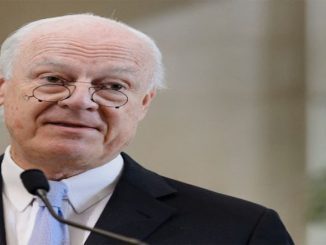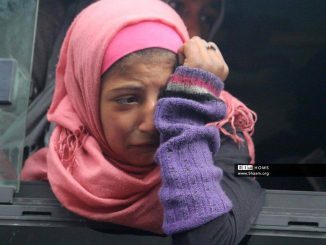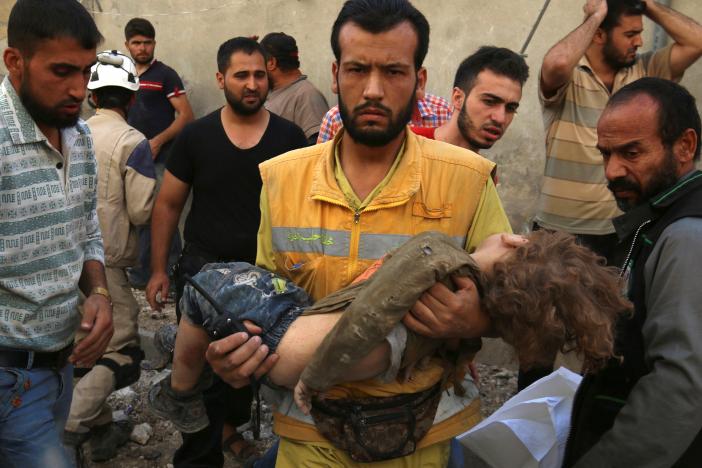
Three years ago, the Syrian researcher George Kadar mentioned to me a new term he called “demographic engineering in Syria”, i.e., redistributing Syria’s population according to new sectarian, religious, and ethnic maps. I thought then that he was exaggerating and that his theory is not realistic and no more than an illusion of the educated.
What I thought an illusion is becoming overtly and explicitly true. I have never thought that George Kadr’s scenario could be a concrete reality. The redistribution and the demographic cleansing we see in Syria, however, no longer needs any evidence after everyone, on top of them are the regime and its allies the Shiites, openly started to divide Syria and to reshape its human map with a very sharp knife. Even the UN is stamping the new maps as we saw in Darayya where the UN, using its green buses, personally oversaw the displacement of Darayya’s native people to the north of Syria although they have lived in Darayya for hundreds of years.
From now on, I will try to think from outside the box. Was the Syrian revolution really a people’s revolution? Or, was it a “revolution” triggered by outside parties aiming at reshaping Syria demographically? The Assad regime might not have noticed this in the beginning, but when it realized the outside game, it said to itself: as long as everyone wants to mess up with the Syrian combination, why don’t I enter the game and take my share? We noticed that the time the regime and its Iranian and Shiite allies realized the start of the game, they started practicing the human engineering game in Syria skillfully.
Notice how civil records were burned and Homs Muslim Sunni inhabitants who are more than a million were displaced and not allowed to return to it. Notice how Hezbollah and its Iranian backers rushed to control al-Quseir city in Homs countryside and displaced its inhabitants years ago to maintain Shiite Hezbollah areas in Lebanon and merge them with the Syrian areas.
Many thought, three years ago or more, that such a move was a mere step to recapture some areas from the opposition in the to and fro battles. Time, however, proved that it was a well-prepared project within the plan of reshaping the Syrian map demographically.
When we see Hezbollah now cleansing the bordering Zabadani and Madaya area from its inhabitants, destroying tens of thousands of trees to dig tunnels and changing the area into a military zone, we recall how it cleansed al-Quseir years ago.
The connection between what it did in al-Quseir and what it is doing now in Zabadani is clear. We do not have to forget the important area of Palmyra which was not well circulated in the media. Its people were displaced because it is located on the way that links Iran with Hezbollah strongholds in Homs and Lebanon via Iraq.
The demographic change game in Syria is not played only by the regime and its allies. Rather, many parties intruded as we aforementioned and were planning it since the revolution broke out. The Kurds, with the US and West support, started cleansing the Arab areas they wanted to control in the north years ago, possibly in coordination with the regime. When we see the new American bases in Rmeilan, the dividing demographic game becomes more apparent.
Will the Turkish “Euphrates Shield” operation be a mere quick military operation to cleanse the Turkish-Syrian borders from the danger of ISIS and the Kurds? Or does it have other aims? Did not the Turkish deputy prime minister pledge to rebuild the liberated Syrian areas in the north? What does all this mean?
We have to remember the Israeli role in the south as Tel Aviv will not allow Iran to approach the south of Syria; this is why it is expected that it will take its share from Syria’s geography.
The projects we see now started to be clear. Does not this make us re-think of everything? The forced displacement, the demographic change, Iran overrunning of Syria, sharing the influence areas between the US and Russia and the coming of many powers to Syria in coordination with the regime make us believe that all were planned moves, since the start of the revolution, played by foreign powers then followed by the regime and its allies. So, it started implementing what it is internationally ordered to do in Syria at the levels of destruction, displacement and the re-drawing of the maps.
Was Homs destruction while displacing its people the second stage of “Homs Dream” project which started by ex-governor Eyad Ghazal? The regime is talking today about building bigger housing complexes in al-Waer while trying to displace the remaining inhabitants.
Have the regime and international companies put organizational charts for many of the areas they destroyed and displaced their people even before the obligatory displacement operation is over? In other words, were they planning for these projects a long time ago, possibly before the revolution? Notice for example that Assad jets targeted certain specific areas in Qudsayya city in Damascus and destroyed them completely while avoiding other areas as if it were telling us: the areas we destroy are to be rebuilt differently according to the new organizational chart in Syria which we have planned, probably before the revolution. Notice how Iran started rebuilding Darayya after displacing its people. We do not have to forget its projects in al-Mezza area in Damascus and the displacement of its people under the pretext of developing the area.
The intricacies of the Syrian case and its overlapping invite to think out of the box even if our new way of thinking looked sort of madness, raving, surrealist or a form of hallucination. Do not forget that many of the American film scenarios we saw tens of years ago when we used to think of them as imaginary have become a tangible reality now.
Faisal al-Kasem – Orient News



